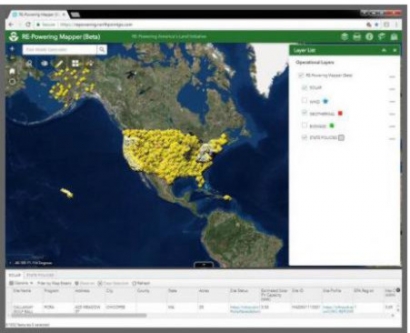
The mapping tool, which is intended be used on former industrial sites, landfills, and mines, was updated as part of the EPA's RE-Powering America’s Land Initiative.
“EPA is not only helping communities across the country clean up contaminated sites, but we are also helping them redevelop those sites for renewable energy production,” said acting EPA Administrator Andrew Wheeler in a written statement.
“EPA’s updated RE-Powering Mapper is a valuable tool for the public to use in transforming hazardous sites into assets that can serve the community for years to come,” he said.
The agency said in a release announcing the tool update that converting these sites, many of which have been vacant or underutilized for years, to renewable energy uses benefits communities in a number of ways.
In addition to providing a pollution-free source of energy, building renewable energy projects on contaminated properties improves the local tax base, creates jobs, and turns blight into an economic opportunity.
The agency's RE-Powering Mapper was developed by the National Renewable Energy Laboratory. The interactive web application has already been used to pre-screen more than 130,000 sites for their renewable energy potential.
As part of this effort, EPA collaborated with state agencies from California, Colorado, Connecticut, Florida, Hawaii, Illinois, Maryland, Massachusetts, Minnesota, Missouri, New Jersey, New York, Oregon, Pennsylvania, Texas, Virginia, and West Virginia.
The Mapper includes 36,400 sites collected from EPA program databases, including: Superfund, Brownfields grantees, RCRA Corrective Action, and the Landfill Methane Outreach Program; as well as 97,500 sites collected from state programs in 17 partnering states.
The Mapper's features include:
In addition to the updated Mapper, EPA has recently released other resources to help encourage the development of renewable energy projects on contaminated and under-used properties.
These include a new training module to educate stakeholders about the various land use considerations for pursuing renewable energy projects on contaminated lands. Topics include: site control and ownership; liability concerns; site clean-up status and timeline, and environmental permitting requirements.
Another resource is the EPA's Fall 2018 Benefits Matrix, which summarizes more than 200 reported benefits associated with completed RE-Powering projects.
Commonly reported benefits include revenues from land leases and taxes, electricity cost savings associated with the reduced need to purchase power from the grid, job creation, and reduced greenhouse gas emissions.
For additional information:

